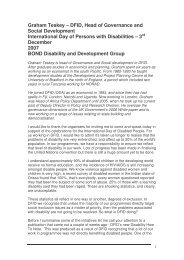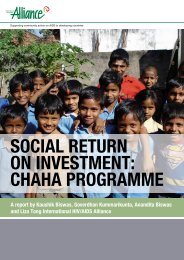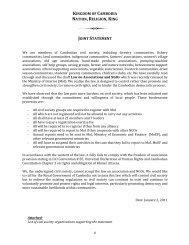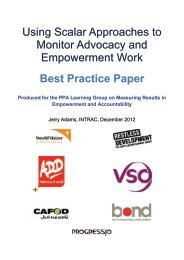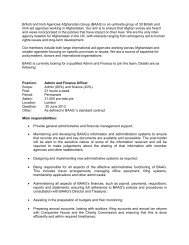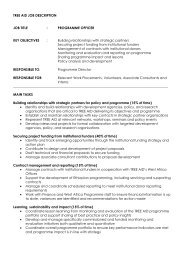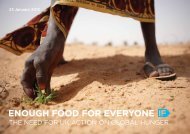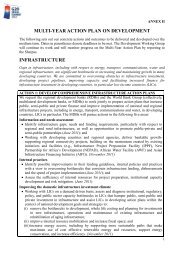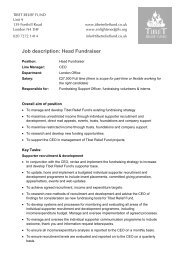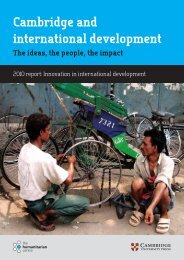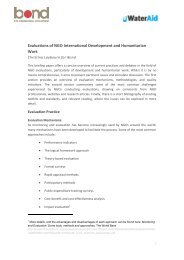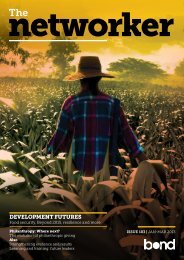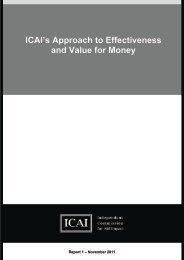beneficiary voice in campaigning - National Council for Voluntary ...
beneficiary voice in campaigning - National Council for Voluntary ...
beneficiary voice in campaigning - National Council for Voluntary ...
Create successful ePaper yourself
Turn your PDF publications into a flip-book with our unique Google optimized e-Paper software.
BENEFICIARY VOICE<br />
IN CAMPAIGNING<br />
A resource jo<strong>in</strong>tly produced<br />
by Bond and NCVO
Beneficiary Voice <strong>in</strong> campaign<strong>in</strong>g<br />
About the authors<br />
Ruth Mayne has extensive experience <strong>in</strong> the<br />
voluntary sector and is currently work<strong>in</strong>g as<br />
a free lance consultant support<strong>in</strong>g voluntary<br />
organisations’ campaign<strong>in</strong>g, advocacy and<br />
community work.<br />
Tim Gee works with NGOs and wider civil society<br />
to support collective action aga<strong>in</strong>st global poverty.<br />
Projects have <strong>in</strong>cluded the Put People First march,<br />
which saw 35,000 people take to the streets ahead<br />
of the London G20 summit, and Stand Up and Take<br />
Action when 100,000 people across the UK took<br />
part <strong>in</strong> actions and events to mark World Day <strong>for</strong><br />
the Eradication of Poverty<br />
This resource<br />
HAS BEEN jo<strong>in</strong>tly<br />
produced by<br />
Bond and NCVO<br />
ABout us<br />
Bond is the UK membership body <strong>for</strong> nongovernmental<br />
organisations (NGOs) work<strong>in</strong>g<br />
<strong>in</strong> <strong>in</strong>ternational development. Bond supports<br />
collective action by its members and wider UK<br />
civil society to <strong>in</strong>fluence the policies and practice<br />
of governments and <strong>in</strong>stitutions at the UK,<br />
Europe and at the <strong>in</strong>ternational level.<br />
www.bond.org.uk<br />
Campaign<strong>in</strong>g Effectiveness, NCVO supports<br />
and empowers people and organisations to<br />
change their world through campaign<strong>in</strong>g and<br />
<strong>in</strong>fluenc<strong>in</strong>g policy. We br<strong>in</strong>g together experience<br />
and expertise and drive excellence <strong>in</strong> campaign<strong>in</strong>g<br />
and policy work across civil society by provid<strong>in</strong>g<br />
support knowledge, tools and resources. For<br />
further <strong>in</strong><strong>for</strong>mation about our work go to:<br />
www.ncvo-vol.org.uk/<br />
campaign<strong>in</strong>geffectiveness<br />
The Campaign<strong>in</strong>g and Advocacy workstream<br />
is led by Campaign<strong>in</strong>g Effectiveness, NCVO<br />
and funded by Capacitybuilders. It is a three-year<br />
programme to deliver a programme of activities<br />
to <strong>in</strong>crease understand<strong>in</strong>g, confidence and<br />
skills <strong>in</strong> campaign<strong>in</strong>g and advocacy. Visit:<br />
www.improv<strong>in</strong>gsupport.org.uk/about<br />
to f<strong>in</strong>d out more.
You might call it <strong>in</strong>fluenc<strong>in</strong>g,<br />
<strong>voice</strong>, advocacy or Campaign<strong>in</strong>g,<br />
but all these activities are<br />
about creat<strong>in</strong>g change<br />
What is<br />
campaign<strong>in</strong>g<br />
You might call it <strong>in</strong>fluenc<strong>in</strong>g, <strong>voice</strong>, advocacy or<br />
campaign<strong>in</strong>g, but all these activities are about<br />
creat<strong>in</strong>g change. At NCVO we use the word<br />
campaign<strong>in</strong>g and def<strong>in</strong>e this as the mobilis<strong>in</strong>g of<br />
<strong>for</strong>ces by organisations or <strong>in</strong>dividuals to <strong>in</strong>fluence<br />
others <strong>in</strong> order to effect an identified and desired<br />
social, economic, environmental or political change.<br />
Whatever you call it and whether you are try<strong>in</strong>g<br />
to save a local community centre from clos<strong>in</strong>g<br />
or lobby<strong>in</strong>g government, campaign<strong>in</strong>g is about<br />
creat<strong>in</strong>g a change. The impact is the real change<br />
created by a campaign – the difference it<br />
makes to people’s lives.<br />
04 Introduction<br />
06 Beh<strong>in</strong>d the Scenes<br />
14 On the Stage<br />
22 In the Auditorium<br />
24 Contact<strong>in</strong>g our Beneficiaries<br />
24 Overcom<strong>in</strong>g Difficulties<br />
28 What Next<br />
02 03
Introduction<br />
What is<br />
Beneficiary Voice<br />
In this publication we use the term ‘<strong>beneficiary</strong><br />
<strong>voice</strong>’ <strong>in</strong> campaigns to mean the extent to which<br />
beneficiaries are:<br />
• <strong>in</strong>volved <strong>in</strong> campaign decision mak<strong>in</strong>g, and/or<br />
• directly represented or visible <strong>in</strong> campaign activities.<br />
‘Beneficiaries’ are people directly affected by an<br />
issue who stand to benefit from the outcome of<br />
the campaign. They may <strong>in</strong>clude people affected<br />
by poverty, HIV and AIDS, particular policies or<br />
programmes, disability, discrim<strong>in</strong>ation, social<br />
or environmental <strong>in</strong>justice, or other issues.<br />
In this publication we use the term ‘<strong>beneficiary</strong><br />
organisation’ to mean organisations run by<br />
and <strong>for</strong> beneficiaries, whether membership,<br />
community or user organisations.<br />
We use the term ‘voluntary’ organisation<br />
to mean voluntary and community organisations<br />
that campaign ‘with’ or ‘<strong>for</strong>’ beneficiaries,<br />
or support them <strong>in</strong> other ways.<br />
By ‘campaign’ we mean organised action<br />
to achieve a desired social, economic,<br />
environmental or political change, often<br />
<strong>in</strong>volv<strong>in</strong>g tackl<strong>in</strong>g underly<strong>in</strong>g power relations.<br />
Member of Bond Quality Group<br />
The quality of<br />
an NGO’s work is<br />
primarily determ<strong>in</strong>ed<br />
by the quality of its<br />
relationships with its<br />
<strong>in</strong>tended beneficiaries<br />
Why Beneficiary<br />
Voice is important<br />
There are a number of powerful reasons why<br />
a strong <strong>beneficiary</strong> <strong>voice</strong> can be important:<br />
• It can strengthen campaign effectiveness by<br />
– <strong>in</strong>creas<strong>in</strong>g the campaign’s legitimacy and moral case<br />
– <strong>in</strong>creas<strong>in</strong>g the campaign’s credibility with decision<br />
makers<br />
– <strong>in</strong>creas<strong>in</strong>g or chang<strong>in</strong>g decision makers’<br />
understand<strong>in</strong>g of an issue<br />
– motivat<strong>in</strong>g campaigners and supporters.<br />
• It helps ensure accountability to beneficiaries and<br />
there<strong>for</strong>e that change is relevant and susta<strong>in</strong>able –<br />
research on effective campaigns has shown how<br />
‘long term grassroots <strong>in</strong>volvement is essential to<br />
ensure real change of any type even after <strong>in</strong>itial<br />
policy changes have been achieved’ (Chapman<br />
& Fisher, The Thoughtful Activist).<br />
• It can empower beneficiaries to become active<br />
agents of change by help<strong>in</strong>g strengthen status,<br />
boost self esteem, and improve self efficacy.<br />
• It can strengthen participatory democracy<br />
by strengthen<strong>in</strong>g and widen<strong>in</strong>g the range<br />
of <strong>voice</strong>s that are heard.<br />
• The ‘right to be heard’ is a basic human right<br />
<strong>for</strong> everyone – there is an obligation on us<br />
all to promote <strong>beneficiary</strong> <strong>voice</strong>.<br />
• It can provide opportunities <strong>for</strong> voluntary<br />
organisations to plan <strong>for</strong> the eventual<br />
devolvement of campaigns to beneficiaries.<br />
• It can help voluntary organisations respond to<br />
the <strong>in</strong>creas<strong>in</strong>g external demands <strong>for</strong> them to<br />
be accountable to their constituencies because<br />
of their grow<strong>in</strong>g <strong>in</strong>volvement <strong>in</strong> public service<br />
delivery and participatory democracy.<br />
Sources:<br />
Adapted by the editor from Jim Coe and Tess K<strong>in</strong>gham,<br />
Tips on Good Practice <strong>in</strong> Campaign<strong>in</strong>g, 2007, NCVO<br />
www.ncvo-vol.org.uk/goodpracticecampaign<strong>in</strong>g<br />
Source: Tim Gee Bond, Beneficiary Voice Peer Exchange, 2009<br />
Role<br />
<strong>in</strong> theatre<br />
Playwright – beh<strong>in</strong>d the scenes<br />
Director – beh<strong>in</strong>d the scenes<br />
Actors – visibility on stage<br />
Audience response – <strong>in</strong> the<br />
auditorium<br />
What other<br />
words can be used<br />
Many people object to the term ‘<strong>beneficiary</strong> <strong>voice</strong>’<br />
because it can imply that beneficiaries are passive<br />
subjects, rather than active agents, of change. There<br />
are a number of possible alternative terms (see Annex<br />
1). However, few are applicable <strong>in</strong> all contexts and all<br />
have pros and cons. While recognis<strong>in</strong>g its shortcom<strong>in</strong>gs<br />
this publication uses the term ‘<strong>beneficiary</strong> <strong>voice</strong>’<br />
because it is short and simple.<br />
Role <strong>in</strong> campaign /<br />
<strong>in</strong>volvement <strong>in</strong> decision mak<strong>in</strong>g<br />
Beneficiaries def<strong>in</strong>e what is to be campaigned on i.e. campaign selection.<br />
Beneficiaries plan how the campaign should be implemented.<br />
Beneficiaries are actively and visibly <strong>in</strong>volved <strong>in</strong> implement<strong>in</strong>g the campaign.<br />
Beneficiaries are largely not <strong>in</strong>volved <strong>in</strong> design<strong>in</strong>g, manag<strong>in</strong>g, or deliver<strong>in</strong>g<br />
the campaign, but it is designed <strong>in</strong> their <strong>in</strong>terest and they have the power<br />
to hold the campaign to account.<br />
What k<strong>in</strong>d of<br />
<strong>beneficiary</strong> <strong>voice</strong><br />
This publication uses the metaphor of roles <strong>in</strong><br />
the theatre to dist<strong>in</strong>guish between different k<strong>in</strong>ds –<br />
or levels of – <strong>beneficiary</strong> <strong>voice</strong> <strong>in</strong> campaign decision.<br />
Different k<strong>in</strong>ds, or levels, of <strong>beneficiary</strong> <strong>in</strong>volvement<br />
can co-exist <strong>in</strong> the same organisation, <strong>for</strong> example <strong>in</strong><br />
some particular campaigns <strong>beneficiary</strong> <strong>voice</strong> may be<br />
high, while <strong>in</strong> others it is low.<br />
Member of Bond Southern Advocacy Quality Group<br />
We should be work<strong>in</strong>g<br />
towards be<strong>in</strong>g facilitators of<br />
the <strong>voice</strong>s of affected people<br />
04 05
eh<strong>in</strong>d<br />
the scenes<br />
campaign issue<br />
selection<br />
campaign<br />
Evaluation<br />
problem analysis<br />
and solutions<br />
Beneficiary Voice<br />
‘beh<strong>in</strong>d the scenes’<br />
By <strong>beneficiary</strong> <strong>voice</strong> ‘beh<strong>in</strong>d the scenes’ we<br />
mean the extent to which beneficiaries are<br />
<strong>in</strong>volved <strong>in</strong> decision mak<strong>in</strong>g about campaigns.<br />
In assess<strong>in</strong>g the extent of their <strong>in</strong>volvement<br />
<strong>in</strong> decision mak<strong>in</strong>g it is useful to dist<strong>in</strong>guish<br />
between whether beneficiaries:<br />
• have <strong>for</strong>mal powers to make decisions<br />
• have delegated authority to make decisions<br />
• are consulted about decisions<br />
• are <strong>in</strong><strong>for</strong>med about decisions.<br />
It is also useful to dist<strong>in</strong>guish whether beneficiaries<br />
are <strong>in</strong>volved <strong>in</strong> decision mak<strong>in</strong>g <strong>in</strong> some, or all<br />
stages, of the campaign cycle. See the cycle<br />
diagram on the opposite page.<br />
campaign<br />
Monitor<strong>in</strong>g/<br />
Learn<strong>in</strong>g<br />
the<br />
campaign<br />
cycle<br />
campaign<br />
Plann<strong>in</strong>g<br />
campaign design<br />
06 07
Case study:<br />
The Ramblers<br />
Association<br />
Democratic decision mak<strong>in</strong>g<br />
Democratic decision mak<strong>in</strong>g is when beneficiaries<br />
have decision mak<strong>in</strong>g power over all stages of the<br />
campaign cycle. This is possible when campaigns<br />
are run ‘by’ beneficiaries organisations themselves,<br />
whether <strong>in</strong><strong>for</strong>mal community or grassroots<br />
organisations, or more <strong>for</strong>mal membership<br />
or user organisations.<br />
In pr<strong>in</strong>ciple democratic decision mak<strong>in</strong>g is the ideal<br />
<strong>for</strong>m of <strong>beneficiary</strong> <strong>voice</strong>. At its best it enables high<br />
levels of <strong>beneficiary</strong> ownership, empowerment and<br />
motivation, as well as ensur<strong>in</strong>g the legitimacy and<br />
relevance of campaigns.<br />
Ramblers Association case study Campaign<strong>in</strong>g<br />
Effectiveness, NCVO “Count Me In” resource<br />
www.ncvo-vol.org.uk/count-me-<strong>in</strong>/ramblersassociation<br />
the back<strong>in</strong>g of 139,000 members<br />
gives huge legitimacy to campaign<br />
demands and also moral support<br />
to campaigners when they lobby<br />
and take campaign actions<br />
08<br />
However, democratic decision mak<strong>in</strong>g by<br />
beneficiaries is not always possible or effective.<br />
Beneficiaries that are geographically dispersed,<br />
vulnerable or politically at risk may f<strong>in</strong>d it difficult or<br />
impossible to organise. Some groups of beneficiaries<br />
(e.g. the world’s poor) cannot <strong>in</strong> their entirety<br />
participate <strong>in</strong> a s<strong>in</strong>gle democratic campaign.<br />
Marg<strong>in</strong>alised or m<strong>in</strong>ority groups may not have<br />
access to decision makers, or the f<strong>in</strong>ancial resources<br />
needed to run effective campaigns. In practice<br />
democratic decision mak<strong>in</strong>g can sometimes be time<br />
consum<strong>in</strong>g and cumbersome, result <strong>in</strong> lowest<br />
common denom<strong>in</strong>ator decisions, or be dom<strong>in</strong>ated<br />
by cliques or <strong>in</strong>terest groups. But these problems<br />
can be avoided if decision mak<strong>in</strong>g is well managed<br />
and there is a genu<strong>in</strong>e participatory culture.<br />
The Ramblers Association is an example of a highly<br />
participative membership organisation that runs its<br />
own campaigns. It is Brita<strong>in</strong>’s largest walk<strong>in</strong>g association<br />
with nearly 140,000 members. It is directed and<br />
controlled by its membership which has the power to<br />
elect the Board and approve policy <strong>in</strong>clud<strong>in</strong>g the<br />
selection and prioritisation of the organisation’s<br />
campaigns and scrut<strong>in</strong>y of their progress.<br />
The General <strong>Council</strong> is the highest decision mak<strong>in</strong>g<br />
body of the organisation. Each year around 300<br />
delegates, selected by their area, attend and vote<br />
on the programme of the Association <strong>for</strong> the<br />
<strong>for</strong>thcom<strong>in</strong>g year. This meet<strong>in</strong>g is the culm<strong>in</strong>ation of a<br />
lengthy and highly participative process. In the run up<br />
to General <strong>Council</strong> all Ramblers’ local groups from 53<br />
regions will have their Annual General Meet<strong>in</strong>g<br />
where any <strong>in</strong>dividual member can propose motions<br />
to be sent to General <strong>Council</strong> <strong>for</strong> membership-wide<br />
discussion and agreement or rejection.<br />
The motions that are passed become policy or the<br />
campaign aim and are carried out by staff who have to<br />
report on action to the General <strong>Council</strong> the follow<strong>in</strong>g<br />
year. The democratic nature of campaign selection<br />
does create a large workload <strong>for</strong> the staff but they<br />
strongly believe its benefits outweigh the costs.<br />
Other examples<br />
Democratic decision mak<strong>in</strong>g models are widely used<br />
by other membership organisations. Examples<br />
<strong>in</strong>clude the London Cycl<strong>in</strong>g Campaign and the<br />
Muslim <strong>Council</strong> of Brita<strong>in</strong>. In the NUS, only those<br />
who self-def<strong>in</strong>e as black, LGBT, disabled or women,<br />
have a <strong>voice</strong> <strong>in</strong> <strong>in</strong>fluenc<strong>in</strong>g campaigns <strong>for</strong> those groups.<br />
On the global level campaigners can <strong>for</strong>m<br />
<strong>in</strong>ternational democratic campaign<strong>in</strong>g structures<br />
such as those <strong>for</strong>med by the International Trades<br />
Union Congress and the Global Call to Action aga<strong>in</strong>st<br />
Poverty. Northern NGOs often <strong>for</strong>m their policy and<br />
priorities based on the decisions of democratic<br />
organisations <strong>in</strong> the South.<br />
The Ramblers<br />
Association<br />
is an example<br />
of a highly<br />
participative<br />
membership<br />
organisation<br />
that runs<br />
its own<br />
campaigns<br />
Source: Adapted from Campaign<strong>in</strong>g<br />
Effectiveness, NCVO “Count Me In”<br />
resource www.ncvo-vol.org.uk/countme<strong>in</strong><br />
09
Case study:<br />
UNEARTH<br />
JUSTICE<br />
Case study:<br />
TRADING<br />
VISIONS<br />
Consultation<br />
with beneficiaries<br />
Consultation with beneficiaries’ is a model<br />
used by voluntary groups which campaign<br />
‘on behalf of’ or ‘<strong>for</strong>’ beneficiaries.<br />
In these cases the voluntary organisation reta<strong>in</strong>s<br />
the f<strong>in</strong>al say over the campaign but consults with<br />
beneficiaries to get their <strong>in</strong>put.<br />
Campaigns run by voluntary organisations ‘<strong>for</strong>’<br />
beneficiaries can be helpful when beneficiaries are<br />
not able to organise and campaign ‘by’ themselves.<br />
They can also be helpful when <strong>beneficiary</strong> organisations<br />
have been delegitimised or marg<strong>in</strong>alised by decision<br />
makers, or lack the resources and skills necessary to<br />
run an effective campaign.<br />
In such cases it is vital that voluntary organisations<br />
consult with beneficiaries to help ensure that the<br />
campaign has legitimacy and that change is relevant<br />
and susta<strong>in</strong>able to their needs. However, consultation<br />
can be tricky to get right, and time consum<strong>in</strong>g (see<br />
Overcom<strong>in</strong>g difficulties section). Yet if you get it<br />
wrong beneficiaries may feel disappo<strong>in</strong>ted and<br />
further disempowered.<br />
Clare Lyons, CAFOD<br />
the partners were positive<br />
about the consultation<br />
and saw it as a valuable<br />
opportunity to lobby<br />
CAFOD, and an advocacy<br />
success that we<br />
subsequently decided<br />
to focus on extractives<br />
‘Unearth Justice’ is a campaign run by<br />
CAFOD on the extractives <strong>in</strong>dustry. M<strong>in</strong><strong>in</strong>g<br />
is often a cause of conflict, environmental<br />
destruction and toxic pollution.<br />
The campaign calls on governments and m<strong>in</strong><strong>in</strong>g<br />
companies to end this <strong>in</strong>justice, and give poor<br />
communities a greater say <strong>in</strong> whether m<strong>in</strong><strong>in</strong>g<br />
is allowed, how it operates, and who benefits.<br />
A three year plann<strong>in</strong>g process preceded the launch.<br />
This <strong>in</strong>cluded a consultation of overseas and UK<br />
staff and partners. After consideration of responses<br />
by UK staff, economic justice was recommended to<br />
the board as the theme of the CAFOD campaign,<br />
with a focus on m<strong>in</strong><strong>in</strong>g.<br />
When the campaign was launched <strong>in</strong> 2006, the<br />
partners had a very strong presence, with case<br />
studies from Honduras and the DRC. There was<br />
a speaker tour and partners were present at the<br />
launch. This was followed <strong>in</strong> 2008 by a photo<br />
exhibition. In addition to mass actions target<strong>in</strong>g<br />
jewellers, CAFOD has privately engaged with<br />
three <strong>in</strong>dividual m<strong>in</strong><strong>in</strong>g companies.<br />
CAFOD <strong>in</strong>vested <strong>in</strong> campaigns resource people<br />
to be the l<strong>in</strong>k between CAFOD and partners,<br />
visit<strong>in</strong>g communities and gett<strong>in</strong>g feedback.<br />
The partners were very positive about the<br />
campaign, and asked <strong>for</strong> a greater say <strong>in</strong> the<br />
plann<strong>in</strong>g phase as well. However, <strong>beneficiary</strong><br />
<strong>in</strong>volvement <strong>in</strong> the campaign also generated some<br />
tensions. Those partners aga<strong>in</strong>st m<strong>in</strong><strong>in</strong>g per se saw<br />
CAFOD as be<strong>in</strong>g too mild <strong>in</strong> their commitment to<br />
‘constructive engagement’.<br />
Source: Presentation by<br />
Clare Lyons (CAFOD)<br />
to Beneficiary Voice<br />
Peer Exchange, 2009)<br />
Involvement on<br />
the govern<strong>in</strong>g body<br />
In this model <strong>beneficiary</strong> representatives <strong>for</strong>m<br />
part of the govern<strong>in</strong>g structures of a voluntary<br />
organisation alongside other stakeholders. This<br />
provides them with oversight and scrut<strong>in</strong>y, but<br />
not overall control of campaign activities.<br />
This approach can be a simple way <strong>for</strong> voluntary<br />
organisations to promote the <strong>voice</strong> of beneficiaries.<br />
It is particularly useful if beneficiaries do not have<br />
the desire, time or expertise to have full control<br />
over decision mak<strong>in</strong>g. The model works best<br />
when beneficiaries have a mean<strong>in</strong>gful stake<br />
on the govern<strong>in</strong>g body and are accountable<br />
to their constituents.<br />
Potential challenges <strong>in</strong>clude prevent<strong>in</strong>g<br />
<strong>beneficiary</strong> <strong>voice</strong>s be<strong>in</strong>g diluted or drowned<br />
out by other govern<strong>in</strong>g body members, the<br />
difficulty of select<strong>in</strong>g beneficiaries without<br />
rais<strong>in</strong>g expectations among all groups, and the<br />
logistics and costs of gett<strong>in</strong>g people to meet<strong>in</strong>gs.<br />
Trad<strong>in</strong>g Visions is an educational charity owned by<br />
Div<strong>in</strong>e Chocolate Company. It aims to alleviate the<br />
poverty of small-scale producers <strong>in</strong> the South by<br />
amplify<strong>in</strong>g their <strong>voice</strong>s <strong>in</strong> the supply cha<strong>in</strong>, and<br />
connect<strong>in</strong>g them with consumers so that they<br />
themselves can challenge and change consumer<br />
behaviour and <strong>in</strong>dustry practice.<br />
Kuapo Kokoo, a democratically run Ghanaian<br />
farmers cooperative, owns 45% of the shares <strong>in</strong><br />
Div<strong>in</strong>e, and two of its members are directors on<br />
the company’s board. One out of four board<br />
meet<strong>in</strong>gs every year is held <strong>in</strong> Ghana.<br />
This structure means that the farmers have a<br />
mean<strong>in</strong>gful <strong>in</strong>put <strong>in</strong>to decisions about how Div<strong>in</strong>e’s<br />
chocolate is produced and sold, as well as over the<br />
activities of Trad<strong>in</strong>g Visions. As shareholders, they<br />
also receive a share of the profits from the sale of<br />
Div<strong>in</strong>e products.<br />
Other examples<br />
Many domestic voluntary organisations also<br />
have <strong>beneficiary</strong> representatives on their board –<br />
<strong>for</strong> example, half of the board of the <strong>Council</strong> of<br />
Management at the mental health charity M<strong>in</strong>d<br />
must have direct experience of mental distress.<br />
Source: Tom Allen,<br />
Trad<strong>in</strong>g Visions Coord<strong>in</strong>ator,<br />
presentation to Beneficiary<br />
Voice Peer Exchange, 2009<br />
One out of four<br />
board meet<strong>in</strong>gs every<br />
year is held <strong>in</strong> Ghana<br />
10 11
Case study:<br />
Leonard<br />
Cheshire<br />
Disability<br />
Support<strong>in</strong>g autonomous<br />
campaigns group<br />
<strong>Voluntary</strong> organisations can play an important<br />
role <strong>in</strong> support<strong>in</strong>g beneficiaries to <strong>for</strong>m their own<br />
organisations and/or design and implement their<br />
own campaigns.<br />
This can be a powerful way of empower<strong>in</strong>g<br />
beneficiaries to become active agents of<br />
change and realise their right to be heard.<br />
Beneficiary groups may require considerable<br />
support <strong>in</strong> the early days. This may <strong>in</strong>clude fund<strong>in</strong>g,<br />
capacity build<strong>in</strong>g, political <strong>in</strong>telligence, or access to<br />
decision makers. Provid<strong>in</strong>g opportunities <strong>for</strong> <strong>beneficiary</strong><br />
groups to learn from the best practice of other<br />
groups can be a particularly effective <strong>for</strong>m of support.<br />
If you go down this route you need to accept that<br />
beneficiaries may challenge your policies and practice.<br />
Graham Bennett,<br />
One World Action<br />
We don’t want to extract<br />
the partner’s <strong>voice</strong> and<br />
regurgitate it when it suits<br />
us. We want to empower<br />
the people we work with<br />
Leonard Cheshire Disability (LCD) has <strong>in</strong>vested<br />
heavily <strong>in</strong> creat<strong>in</strong>g Campaign Action Groups (CAGs).<br />
These are not ‘Leonard Cheshire Disability’ groups,<br />
but <strong>in</strong>dependent groups of disabled people who set<br />
their own agendas and methods of work<strong>in</strong>g. LCD<br />
acts as a facilitator and support to these<br />
<strong>in</strong>dependent groups.<br />
The groups have had some positive successes.<br />
For example, one group succeeded <strong>in</strong> gett<strong>in</strong>g<br />
a McDonalds restaurant to fit a new accessible<br />
toilet, a table designed <strong>for</strong> wheelchair users and<br />
all staff to receive disabled equality tra<strong>in</strong><strong>in</strong>g.<br />
This approach is potentially embarrass<strong>in</strong>g to LCD –<br />
itself a major provider of services to disabled people<br />
and sometimes funded by Local Authorities.<br />
However, LCD is clear that the Groups should not<br />
be prevented from criticis<strong>in</strong>g any target that they<br />
identify, and that funds and support should be<br />
distributed equally to them even if they wish to<br />
target aspects of LCD service provision.<br />
In order to enshr<strong>in</strong>e this right and also prevent<br />
any conflicts of <strong>in</strong>terest, <strong>for</strong>mal agreements are<br />
set up between the Campaign Action Groups and<br />
LCD, which enshr<strong>in</strong>e the groups’ <strong>in</strong>dependence<br />
(with<strong>in</strong> the conf<strong>in</strong>es of charity law).<br />
Other examples<br />
One World Action’s ‘More Women More Power’<br />
campaign supports women’s groups from around<br />
the world to come together to <strong>for</strong>m <strong>in</strong>ternational<br />
campaigns. Street Child World Cup works with<br />
Street Children to identify issues, and help<br />
them to deal with them.<br />
Source: Adapted from Campaign<strong>in</strong>g<br />
Effectiveness, NCVO “Count Me In” resource<br />
www.ncvo-vol.org.uk/count-me-<strong>in</strong>/campaignactiongroups<br />
one group<br />
succeeded<br />
<strong>in</strong> gett<strong>in</strong>g<br />
a McDonalds<br />
restaurant<br />
to fit a new<br />
accessible<br />
toilet AND<br />
a table<br />
designed <strong>for</strong><br />
Wheelchair<br />
users<br />
12 13
Diplomat quoted <strong>in</strong> Independent<br />
Evaluation of the Ban Advocates Initiative<br />
on the stage<br />
Beneficiary Voice<br />
‘on the stage’<br />
Beneficiary Voice or visibility is the extent to which<br />
beneficiaries are directly represented <strong>in</strong> campaign<br />
activities – whether lobby meet<strong>in</strong>gs, media work,<br />
public hear<strong>in</strong>gs, speaker tours or public<br />
mobilisations. We look at several possible<br />
approaches through this section.<br />
Direct<br />
advocacy<br />
Direct advocacy is when beneficiaries are directly<br />
and visibly <strong>in</strong>volved <strong>in</strong> campaign activities aimed at<br />
decision makers. Face to face lobby<strong>in</strong>g, <strong>for</strong> example,<br />
can be a very powerful way of <strong>in</strong>fluenc<strong>in</strong>g decision<br />
makers’ views on an issue. It can also <strong>in</strong>crease<br />
campaign effectiveness and be highly motivat<strong>in</strong>g<br />
to both beneficiaries and campaign supporters alike.<br />
Involv<strong>in</strong>g beneficiaries <strong>in</strong> this way can also be time<br />
consum<strong>in</strong>g and resource <strong>in</strong>tensive. You need to take<br />
time to consult and build trust with beneficiaries. You<br />
may also need to provide beneficiaries with tra<strong>in</strong><strong>in</strong>g,<br />
support networks, f<strong>in</strong>ancial and logistical support,<br />
and where appropriate psychological support.<br />
Ultimately you need to accept that beneficiaries may<br />
present views to decision makers that differ, or even<br />
conflict, with the views of your organisation<br />
The Ban Advocates were<br />
experts <strong>in</strong> the human effects<br />
of cluster munitions. they<br />
brought specific experience<br />
which helped elaboration<br />
of Victim Assistance clause.<br />
I learnt a lot from them<br />
as they could tell me how<br />
th<strong>in</strong>gs work on the ground<br />
and they raised several<br />
th<strong>in</strong>gs I hadn’t thought of<br />
14 15
Case study:<br />
Ban Advocates<br />
Case study:<br />
Oxfam’s Climate<br />
Change hear<strong>in</strong>gs<br />
The ‘Ban Advocates Initiative’ is a powerful<br />
and effective example of an advocacy <strong>in</strong>itiative<br />
which gave beneficiaries a direct, active and<br />
highly visible <strong>voice</strong> <strong>in</strong> campaign activities.<br />
Handicap International helped facilitate a group<br />
of people from around the world who had been<br />
affected by cluster bombs to participate <strong>in</strong> the<br />
<strong>in</strong>ternational negotiations on cluster munitions.<br />
They were directly <strong>in</strong>volved <strong>in</strong> plann<strong>in</strong>g and<br />
implement<strong>in</strong>g advocacy activities <strong>in</strong>clud<strong>in</strong>g<br />
presentations at <strong>in</strong>ternational conferences,<br />
meet<strong>in</strong>g diplomats and media work.<br />
An <strong>in</strong>dependent evaluation showed that the<br />
Ban Advocates helped <strong>in</strong>crease the legitimacy<br />
and moral case <strong>for</strong> an <strong>in</strong>ternational ban on cluster<br />
munitions, and <strong>in</strong>fluenced the views and, <strong>in</strong> some<br />
cases, positions of diplomats As one respondent<br />
said “Their’ capacity to move people was important.<br />
It was quite difficult <strong>for</strong> diplomats to keep their<br />
humanity <strong>in</strong> check <strong>in</strong> order to represent <strong>in</strong>stitutional<br />
positions. The Ban Advocates brought their<br />
humanity to the <strong>for</strong>e – and were very<br />
powerful <strong>in</strong> do<strong>in</strong>g so.”<br />
Because of their direct knowledge of the issue<br />
the Ban Advocates helped strengthen the text of<br />
the convention, particularly on victim assistance.<br />
Their <strong>in</strong>volvement also helped secure high-profile<br />
media coverage <strong>for</strong> the campaign.<br />
Other examples<br />
Development organisations often <strong>in</strong>volve<br />
beneficiaries directly <strong>in</strong> advocacy. ActionAid<br />
<strong>for</strong> example brought South African fruit farmer<br />
Gertruida Baartman to Tesco’s Annual Meet<strong>in</strong>g<br />
<strong>in</strong> the UK where she spoke out about the pay and<br />
conditions of those who produce Tesco food.<br />
Sources: Adapted from the Presentation to Beneficiary Voice Peer<br />
Exchange by Stan Brabant and Stephanie Castanie Handicap<br />
International, and Independent Evaluation of<br />
the Ban Advocate Initiative, Ruth Mayne, <strong>for</strong>thcom<strong>in</strong>g<br />
Speaker tours<br />
Speaker tours are a <strong>for</strong>m of direct advocacy <strong>in</strong> which<br />
one or more beneficiaries travel around a country<br />
to speak at meet<strong>in</strong>gs with decision makers and/or<br />
members of the public. It is an approach often used<br />
by <strong>in</strong>ternational campaigns to <strong>in</strong><strong>for</strong>m and motivate<br />
supporters and local groups <strong>in</strong> the UK.<br />
Politicians and the public often respond best to<br />
real people so speaker tours can have a powerful<br />
and motivat<strong>in</strong>g impact on campaign audiences. They<br />
can also be reward<strong>in</strong>g <strong>for</strong> the beneficiaries <strong>in</strong>volved.<br />
Speaker tours run the risk of tokenism or unduly<br />
raise beneficiaries’ expectations. However this can<br />
be avoided if beneficiaries are also actively <strong>in</strong>volved<br />
<strong>in</strong> other aspects of the campaign. Speaker tours can<br />
also be resource and time <strong>in</strong>tensive to organise and<br />
require careful logistical plann<strong>in</strong>g <strong>in</strong>clud<strong>in</strong>g<br />
provid<strong>in</strong>g <strong>in</strong>terpreters where needed.<br />
Examples<br />
People and Planet, Jubilee Debt Campaign, Fairtrade<br />
Foundation, Oxfam, STOP AIDS Campaign, and<br />
others, have all used this model successfully to<br />
give <strong>voice</strong> and a plat<strong>for</strong>m <strong>for</strong> people to share<br />
experiences and raise awareness.<br />
Public hear<strong>in</strong>gs<br />
Public hear<strong>in</strong>gs are another way <strong>for</strong> beneficiaries<br />
to present their own experiences and views directly<br />
to campaign audiences. They typically <strong>in</strong>volve a<br />
public meet<strong>in</strong>g at which decision makers and/or<br />
the public are <strong>in</strong>vited to hear testimonies, and<br />
recommendations, from a range of beneficiaries.<br />
If well organised public hear<strong>in</strong>gs can <strong>for</strong>m a useful<br />
part of a campaign strategy by help<strong>in</strong>g <strong>in</strong>fluence<br />
decision makers and motivate campaign supporters.<br />
They can also attract media attention if you <strong>in</strong>vite<br />
local musicians, dancers, poets, drama groups,<br />
celebrities etc. A potential risk is that public hear<strong>in</strong>gs<br />
may raise beneficiaries’ expectations so be clear<br />
about the likely outcomes at the outset and hold<br />
a debrief<strong>in</strong>g with beneficiaries after the hear<strong>in</strong>g.<br />
If the issue is contentious public exposure may<br />
<strong>in</strong>advertently put beneficiaries at risk, so you<br />
need to jo<strong>in</strong>tly assess and plan <strong>for</strong> any potential<br />
risks be<strong>for</strong>ehand.<br />
Jenny Dawk<strong>in</strong>s, Street Child World Cup<br />
In my experience there is<br />
noth<strong>in</strong>g more powerful<br />
than meet<strong>in</strong>g with someone<br />
directly affected by<br />
someth<strong>in</strong>g. Enabl<strong>in</strong>g<br />
communication between<br />
someone <strong>in</strong> the UK that<br />
wants to make change<br />
happen and someone abroad<br />
try<strong>in</strong>g to make change<br />
happen is deeply <strong>in</strong>spir<strong>in</strong>g<br />
In 2009, Oxfam held climate hear<strong>in</strong>gs<br />
all over the world to enable the <strong>voice</strong>s of<br />
people affected by climate change to be<br />
heard by decision makers and delegates.<br />
Around 1.5 million people from 36 countries<br />
eventually took part <strong>in</strong> local and national hear<strong>in</strong>gs<br />
on boats <strong>in</strong> Bangladesh, runn<strong>in</strong>g races <strong>in</strong> Ethiopia<br />
and on mounta<strong>in</strong>s high <strong>in</strong> the Peruvian Andes.<br />
In the UK local hear<strong>in</strong>gs were organised by Oxfam<br />
offices <strong>in</strong> the months lead<strong>in</strong>g up to Copenhagen.<br />
Activists were encouraged to get <strong>in</strong>volved and<br />
where possible organise their own events. The UK<br />
Secretary of State <strong>for</strong> Energy and Climate Change,<br />
Ed Miliband, attended the hear<strong>in</strong>g <strong>in</strong> Doncaster.<br />
A global hear<strong>in</strong>g subsequently took place at the<br />
United Nations Framework Convention on Climate<br />
Change (UNFCCC) conference <strong>in</strong> Copenhagen<br />
Denmark. A powerful panel of advocates was<br />
assembled with negotiators, government m<strong>in</strong>isters<br />
and other delegates <strong>in</strong>vited to attend. Materials<br />
from the local and national hear<strong>in</strong>gs were presented.<br />
Other examples<br />
In recent years this model has been taken<br />
up by a range of campaign<strong>in</strong>g groups.<br />
One example is the Global Call to Action aga<strong>in</strong>st<br />
Poverty (GCAP) which uses ‘Poverty Hear<strong>in</strong>gs’<br />
to put the <strong>voice</strong>s of beneficiaries centre stage.<br />
Church Action on poverty has organised over<br />
100 “Poverty Hear<strong>in</strong>gs”. Read more about this<br />
on their website:<br />
www.church-poverty.org.uk/<br />
get<strong>in</strong>volved/poverty-hear<strong>in</strong>gs<br />
16 17
Case study:<br />
WITNESS<br />
New media<br />
This model <strong>in</strong>volves us<strong>in</strong>g new media tools – such<br />
as Facebook, Twitter, podcasts, blogs – that allow<br />
beneficiaries to speak directly to campaign<br />
audiences <strong>in</strong> their own <strong>voice</strong>s.<br />
New media provides a powerful and cheap way <strong>for</strong><br />
beneficiaries to speak directly to campaign audiences<br />
if they cannot be physically present <strong>for</strong> geographical or<br />
logistical reasons, <strong>for</strong> example <strong>in</strong> global campaign<strong>in</strong>g.<br />
A big advantage is that it allows beneficiaries to have<br />
control over how their story is presented.<br />
A potential downside is that not all beneficiaries or<br />
audiences have access to the <strong>in</strong>ternet. Beneficiaries<br />
may also need tra<strong>in</strong><strong>in</strong>g to be able to use the<br />
technology. Also, if beneficiaries do not have f<strong>in</strong>al<br />
editorial control over the content they may be<br />
<strong>in</strong>advertently misrepresented.<br />
The Human Rights group WITNESS provides<br />
tra<strong>in</strong><strong>in</strong>g, support and equipment to local groups<br />
to use video as an advocacy tool <strong>in</strong> their human<br />
rights advocacy campaigns. WITNESS helps<br />
promote the videos with <strong>in</strong>ternational media<br />
outlets, government officials, policymakers,<br />
activists, and the general public.<br />
Other examples<br />
In the run up to crucial climate change talks <strong>in</strong><br />
Copenhagen CAFOD recorded and released a<br />
series of videos where the human impacts of a<br />
chang<strong>in</strong>g climate were shown first hand, and<br />
Southern activists called on activists <strong>in</strong> the UK<br />
to jo<strong>in</strong> them <strong>in</strong> tak<strong>in</strong>g action. These were<br />
emailed to supporters.<br />
Trad<strong>in</strong>g Visions uses the <strong>in</strong>ternet to l<strong>in</strong>k<br />
up school classrooms <strong>in</strong> Ghana with school<br />
classrooms <strong>in</strong> the UK so that people can talk<br />
to each other and ask questions. This means<br />
there are fewer problems with power imbalances<br />
than <strong>in</strong> one-way communications.<br />
Us<strong>in</strong>g images<br />
This approach <strong>in</strong>volves the use of images –<br />
such as documentary photos or video diaries –<br />
to tell beneficiaries’ stories. The images may be<br />
produced by beneficiaries themselves, or by others.<br />
Sometimes it is not possible <strong>for</strong> beneficiaries to<br />
tell their stories face to face. They may f<strong>in</strong>d it too<br />
pa<strong>in</strong>ful, or may not feel confident of speak<strong>in</strong>g <strong>in</strong><br />
front of groups or decision makers. So <strong>in</strong> this<br />
situation, pictures can be a very effective<br />
means of communication.<br />
Images can sometimes affect people emotionally<br />
<strong>in</strong> a way that words cannot, cross language barriers,<br />
and they can potentially reach wider audiences than<br />
would be possible from face to face meet<strong>in</strong>gs. Where<br />
beneficiaries are <strong>in</strong>volved <strong>in</strong> produc<strong>in</strong>g the images<br />
of themselves it can be empower<strong>in</strong>g.<br />
However, if beneficiaries do not produce the image<br />
themselves or lack control over their use, they may<br />
be <strong>in</strong>advertently put at risk or misrepresented. It is<br />
there<strong>for</strong>e important to ensure that beneficiaries<br />
either have control over the images, or have given<br />
their <strong>in</strong><strong>for</strong>med consent <strong>for</strong> their use. Photo Voice<br />
has guidance on work<strong>in</strong>g with vulnerable groups<br />
on their website.<br />
www.photo<strong>voice</strong>.org/html/<br />
whoarewe/pvethicalpractice.pdf<br />
Participant <strong>in</strong> Bond Southern<br />
Advocacy Group<br />
The spread of new media<br />
technology means that<br />
br<strong>in</strong>g<strong>in</strong>g <strong>voice</strong>s from the<br />
Global South to decision<br />
makers <strong>in</strong> the North<br />
should be easier than<br />
at any po<strong>in</strong>t <strong>in</strong> history<br />
Matt Daw, PhotoVoice<br />
We are very desensitised<br />
to sanitised charity<br />
adverts. This approach<br />
is far more affect<strong>in</strong>g<br />
18 19
Case study:<br />
PhotoVoice<br />
Source: Presentation Matt Daw<br />
[PhotoVoice] to Beneficiary Voice<br />
Peer Exchange, 2009<br />
Case study:<br />
Everychild<br />
PhotoVoice is an award-w<strong>in</strong>n<strong>in</strong>g <strong>in</strong>ternational charity<br />
which seeks to empower disadvantaged groups by<br />
provid<strong>in</strong>g them with photographic tra<strong>in</strong><strong>in</strong>g with<br />
which they can express themselves, advocate and<br />
generate an <strong>in</strong>come. They work with refugees, street<br />
children, orphans, people affected by HIV/AIDS<br />
and special needs groups.<br />
Their tra<strong>in</strong><strong>in</strong>g workshops allow people who are<br />
traditionally the subjects of photography to become<br />
its creator – and hence ga<strong>in</strong> control over how they<br />
are perceived by the rest of the world. In the Bethnal<br />
Green area of London, <strong>for</strong> example, there was a<br />
postcard campaign by street work<strong>in</strong>g women<br />
that showed that they were not ‘street trash’.<br />
The tra<strong>in</strong><strong>in</strong>g also helps participants ga<strong>in</strong> confidence<br />
<strong>in</strong> their own <strong>voice</strong>s – and speak out about their<br />
challenges, concerns, hopes and fears – while<br />
simultaneously learn<strong>in</strong>g a new skill which can<br />
enhance their lives.<br />
Project participants are given copyright control<br />
of any images they produce, and all photos<br />
have a brief outl<strong>in</strong><strong>in</strong>g the conditions of use.<br />
Other examples<br />
In some cases it is unsafe to show any images<br />
of beneficiaries at all. For example, as part of its<br />
child traffick<strong>in</strong>g campaign, UNICEF partnered<br />
with Amnesty and Anti-Slavery International to<br />
produce a photo exhibition <strong>in</strong> St Paul’s Cathedral<br />
to mark the official end of the legal slave trade.<br />
They worked with Poppy Project – that has a<br />
safe house – and showed photos of th<strong>in</strong>gs that<br />
represented trafficked children, their families and<br />
their experiences, rather than tak<strong>in</strong>g pictures of<br />
the children themselves. (Source: Contribution<br />
by Laura Keely, UNICEF, to Beneficiary<br />
Voice Peer Exchange, 2009)<br />
Re-tell<strong>in</strong>g<br />
beneficiaries’ stories<br />
Re-tell<strong>in</strong>g stories is when a voluntary<br />
organisation features <strong>in</strong>terviews, quotes or<br />
case studies of beneficiaries <strong>in</strong> their publications,<br />
speeches and/or media work. In these cases the<br />
beneficiaries’ stories are represented <strong>in</strong>directly,<br />
or mediated, by the voluntary organisation.<br />
Re-tell<strong>in</strong>g stories may be helpful when beneficiaries<br />
cannot tell their stories face to face to audiences.<br />
It can also enable voluntary organisations to<br />
communicate with wider audiences.<br />
A potential drawback of us<strong>in</strong>g this model is that<br />
campaign audiences can come to feel over saturated<br />
with ‘stories’, distrust the <strong>in</strong>tegrity of the stories or<br />
even feel manipulated. Another risk is that voluntary<br />
organisations may <strong>in</strong>advertently distort the views of<br />
the <strong>beneficiary</strong> to support their campaign messages,<br />
or put vulnerable beneficiaries at risk. This can be<br />
avoided by voluntary organisations obta<strong>in</strong><strong>in</strong>g<br />
beneficiaries’ <strong>in</strong><strong>for</strong>med consent to use their<br />
stories, abid<strong>in</strong>g by agreed pr<strong>in</strong>ciples on<br />
anonymity or confidentiality, and check<strong>in</strong>g<br />
materials with beneficiaries.<br />
When I<br />
am told<br />
stories<br />
I react<br />
emotionally<br />
and this is<br />
reflected<br />
when the<br />
story is<br />
retold<br />
Participant <strong>in</strong> Peer<br />
Exchange, 2008<br />
International Development charity EveryChild<br />
has collaborated with a theatre company who<br />
will per<strong>for</strong>m testimonies gathered from children.<br />
Eventually it is hoped that these will be translated<br />
back so that children can per<strong>for</strong>m to one another.<br />
This is seen as a method of empowerment which<br />
will catalyse some <strong>in</strong>to country advocacy.<br />
Other examples<br />
Many voluntary organisations re-tell stories.<br />
The World Development Movement, <strong>for</strong><br />
example, often features <strong>in</strong>terviews, quotes and<br />
articles by activists liv<strong>in</strong>g <strong>in</strong> the Global South, <strong>in</strong><br />
their publications. At public meet<strong>in</strong>gs, Tourism<br />
Concern makes a conscious ef<strong>for</strong>t to use the words<br />
of partner campaign groups <strong>in</strong> affected countries.<br />
This is seen as<br />
a method of<br />
empowerment<br />
which will<br />
catalyse some<br />
<strong>in</strong>to country<br />
advocacy<br />
20 21
<strong>in</strong> the<br />
auditorium<br />
Due account [ needs to be ] taken<br />
of the needs, capacities and actual<br />
circumstances of the <strong>in</strong>tended<br />
beneficiaries. They are, after all,<br />
the ’pr<strong>in</strong>cipals’ <strong>for</strong> whom<br />
humanitarian action is<br />
designed to serve<br />
Beneficiary Voice<br />
‘<strong>in</strong> the auditorium’<br />
By <strong>beneficiary</strong> <strong>voice</strong> ‘<strong>in</strong> the auditorium’<br />
we mean the ability of beneficiaries to hold<br />
voluntary organisations to account about<br />
campaigns that affect them by provid<strong>in</strong>g<br />
feedback or compla<strong>in</strong>ts.<br />
Accountability mechanisms are particularly<br />
important if beneficiaries are not directly <strong>in</strong>volved<br />
<strong>in</strong> design<strong>in</strong>g, manag<strong>in</strong>g, or deliver<strong>in</strong>g the campaign.<br />
However, it is important to ensure that the<br />
important benefits of greater accountability<br />
do not outweigh the costs of implementation<br />
Accountability<br />
mechanisms<br />
Oxfam GB believes that <strong>in</strong> order to achieve its<br />
organisational mission and to ensure that its work<br />
has the greatest impact it needs to be accountable<br />
to its key stakeholders. These <strong>in</strong>clude the <strong>in</strong>dividuals<br />
and communities with whom it works; partners and<br />
allies; donors and supporters; staff and the wider<br />
public; and regulatory bodies <strong>in</strong> the UK and <strong>in</strong><br />
countries where it operates.<br />
Each year it produces an accountability report<br />
to show how it has been accountable to its multiple<br />
stakeholders through its campaign<strong>in</strong>g, development<br />
and humanitarian work. In each of these areas it<br />
is work<strong>in</strong>g towards:<br />
• Improved transparency and <strong>in</strong><strong>for</strong>mation<br />
shar<strong>in</strong>g <strong>in</strong>clud<strong>in</strong>g publish<strong>in</strong>g evaluations<br />
• Increas<strong>in</strong>g stakeholder participation <strong>in</strong><br />
decision mak<strong>in</strong>g<br />
• Participatory monitor<strong>in</strong>g and evaluation to allow<br />
stakeholders to provide regular feedback about the<br />
relevance, effectiveness, and impact of campaigns<br />
• A compla<strong>in</strong>ts mechanism.<br />
See Oxfam Accountability Report, 2008-09<br />
www.oxfam.org.uk/resources<br />
Other examples<br />
The Humanitarian Accountability Project (HAP)<br />
has developed accountability pr<strong>in</strong>ciples which<br />
are transferable to campaign<strong>in</strong>g organisations.<br />
These <strong>in</strong>clude early consultation with <strong>in</strong>tended<br />
beneficiaries; publish<strong>in</strong>g <strong>beneficiary</strong> entitlement<br />
criteria; and learn<strong>in</strong>g and cont<strong>in</strong>uous improvement.<br />
HAP recommends an optimal rather than a maximal<br />
ef<strong>for</strong>t, where the resources devoted to accountability<br />
and quality management can be justified <strong>in</strong> terms<br />
of humanitarian impact.<br />
One World Trust is a good source of advice<br />
<strong>for</strong> voluntary organisations on accountability<br />
mechanisms and compla<strong>in</strong>ts mechanism.<br />
Sources: Adapted from Humanitarian<br />
Accountability Partnership – and from<br />
One World Trust’s Compla<strong>in</strong>ts mechanism<br />
Humanitarian 22 Accountability Partnership<br />
23
Contact<strong>in</strong>g Beneficiaries<br />
This table looks at some of the<br />
ways that different organisations<br />
use to f<strong>in</strong>d beneficiaries<br />
Method Who uses it<br />
Exist<strong>in</strong>g programmes<br />
Recruit and <strong>in</strong>terview the same<br />
way as you would <strong>for</strong> a job<br />
Your members are your beneficiaries<br />
Grassroots <strong>in</strong>-country advocacy organisations<br />
Welcome applications on your website<br />
Help organise previously unorganised<br />
beneficiaries <strong>in</strong>to groups<br />
CAFOD<br />
Ban Advocates<br />
Ramblers Association, trade unions<br />
Tourism Concern<br />
WITNESS<br />
Leonard Cheshire Disability<br />
K<strong>in</strong>d of problem<br />
that could be faced<br />
Manag<strong>in</strong>g <strong>beneficiary</strong> <strong>in</strong>volvement CONTINUED<br />
There is a lot of problems with<br />
work<strong>in</strong>g with vulnerable groups<br />
which can put them at risk.<br />
Involv<strong>in</strong>g beneficiaries may raise<br />
expectations that can’t be met<br />
Possible responses<br />
• Conduct an analysis of the costs/risks and benefits<br />
<strong>in</strong>volv<strong>in</strong>g beneficiaries actively <strong>in</strong> your campaign.<br />
• Develop a plan to manage risks. See ‘Safeguard<strong>in</strong>g<br />
Children and Young People, Amnesty International<br />
www.amnesty.org/en/library/<strong>in</strong>fo/POL41/001/2008/en<br />
• Develop a clear policy <strong>for</strong> work<strong>in</strong>g with vulnerable groups.<br />
See Photo Voice’s guidance on work<strong>in</strong>g with vulnerable groups<br />
www.photo<strong>voice</strong>.org/html/whoarewe/pvethicalpractice.pdf<br />
• Ensure <strong>in</strong><strong>for</strong>med consent <strong>for</strong> use of images. See Amnesty<br />
International publication ‘Shar<strong>in</strong>g your Stories’.<br />
• Be honest and clear with beneficiaries about the<br />
level of <strong>in</strong>volvement you are seek<strong>in</strong>g from the outset.<br />
• Draw up a memorandum of understand<strong>in</strong>g with beneficiaries.<br />
• Hold regular debriefs with beneficiaries <strong>in</strong>volved <strong>in</strong> campaigns<br />
e.g. after speaker tours or public hear<strong>in</strong>gs.<br />
Gett<strong>in</strong>g <strong>in</strong>stitutional support <strong>for</strong> <strong>beneficiary</strong> <strong>voice</strong> <strong>in</strong> campaigns<br />
OVERCOMING DIFFICULTIES<br />
Involv<strong>in</strong>g and represent<strong>in</strong>g beneficiaries <strong>in</strong><br />
campaigns can raise many challenges. In the<br />
table below we provide a summary of some<br />
of the issues raised <strong>in</strong> this publication, as<br />
well as some ideas of how to respond.<br />
K<strong>in</strong>d of problem<br />
that could be faced<br />
Manag<strong>in</strong>g <strong>beneficiary</strong> <strong>in</strong>volvement<br />
It can be difficult balanc<strong>in</strong>g<br />
and prioritis<strong>in</strong>g the <strong>in</strong>terests<br />
of beneficiaries with those of<br />
other staff and stakeholders<br />
such as donors.<br />
There may be power imbalances<br />
and/or conflicts with<strong>in</strong> or<br />
between <strong>beneficiary</strong> groups.<br />
Possible responses<br />
• Expla<strong>in</strong> and sell the benefits of <strong>beneficiary</strong> <strong>voice</strong><br />
<strong>in</strong> campaigns to other stakeholders (as above).<br />
• Set up advisory panels or assemblies of beneficiaries.<br />
• Introduce participatory monitor<strong>in</strong>g and learn<strong>in</strong>g systems<br />
to demonstrate the value of <strong>beneficiary</strong> feedback.<br />
• Advise fundraisers and campaigners that they need the<br />
<strong>in</strong><strong>for</strong>med consent of ‘beneficiaries’ to use their stories.<br />
• Br<strong>in</strong>g issues and debates <strong>in</strong>to the open.<br />
• Inspire groups with a sense of shared solidarity.<br />
The organisation may<br />
be reluctant to <strong>in</strong>volve<br />
beneficiaries<br />
Identify<strong>in</strong>g beneficiaries<br />
Beneficiaries may not<br />
feel able to be <strong>in</strong>volved<br />
Beneficiary groups may be<br />
dom<strong>in</strong>ated by ‘usual suspects’;<br />
not every <strong>voice</strong> is heard<br />
• Expla<strong>in</strong> and ‘sell’ the benefits of <strong>beneficiary</strong> <strong>voice</strong> to managers and<br />
staff e.g. by expla<strong>in</strong><strong>in</strong>g how it can <strong>in</strong>crease campaign effectiveness.<br />
• Invite managers and staff to meet with beneficiaries.<br />
Set aside time and resources to consult with beneficiaries to f<strong>in</strong>d out<br />
why they do not feel able to get <strong>in</strong>volved, and tailor your response<br />
accord<strong>in</strong>gly. An appropriate response may <strong>in</strong>clude:<br />
• Awareness rais<strong>in</strong>g and capacity build<strong>in</strong>g.<br />
• Address<strong>in</strong>g socio-economic constra<strong>in</strong>ts – such as lack of time,<br />
health, education – that prevent people from participat<strong>in</strong>g.<br />
• Mak<strong>in</strong>g sure adequate support is available<br />
<strong>in</strong>clud<strong>in</strong>g psychological support if appropriate.<br />
• Facilitat<strong>in</strong>g separate spaces <strong>for</strong> beneficiaries<br />
to share experiences and support each other.<br />
• Acknowledg<strong>in</strong>g that responses other than campaign<strong>in</strong>g<br />
may be more appropriate, or simply that beneficiaries<br />
may have other more immediately press<strong>in</strong>g problems.<br />
• Actively seek to understand the power relations and<br />
diversity of op<strong>in</strong>ion with<strong>in</strong> the communities with<br />
whom you work e.g. through participatory research.<br />
• Help empower less powerful and confident <strong>voice</strong>s<br />
through awareness rais<strong>in</strong>g and capacity build<strong>in</strong>g.<br />
• Provide capacity build<strong>in</strong>g <strong>in</strong> participatory leadership<br />
and consultation techniques to <strong>beneficiary</strong> groups.<br />
• Share best practice from other groups.<br />
Sources: Beneficiary Voice Beneficiary Voice Peer Exchanges, 2009 and 2010<br />
24 25
OVERCOMING DIFFICULTIES<br />
CONTINUED<br />
ANNEX 1: WHAT OTHER<br />
TERMS CAN WE USE<br />
K<strong>in</strong>d of problem<br />
that could be faced<br />
Manag<strong>in</strong>g <strong>beneficiary</strong> <strong>in</strong>volvement<br />
Mean<strong>in</strong>gful <strong>beneficiary</strong><br />
<strong>in</strong>volvement is time consum<strong>in</strong>g,<br />
costly and can result <strong>in</strong><br />
cumbersome decision mak<strong>in</strong>g<br />
The complexity of global<br />
decision mak<strong>in</strong>g processes and<br />
relationships, and differences<br />
<strong>in</strong> language and culture, can<br />
make it very difficult to manage<br />
a campaign with effective<br />
<strong>beneficiary</strong> <strong>voice</strong><br />
Possible responses<br />
• Secure an <strong>in</strong>stitutional commitment, budget<br />
and resources from your organisation.<br />
• Agree clear roles, responsibilities, procedures <strong>for</strong><br />
decision mak<strong>in</strong>g and communication channels.<br />
• Monitor and evaluate the effectiveness of <strong>beneficiary</strong><br />
<strong>in</strong>volvement to prevent dim<strong>in</strong>ish<strong>in</strong>g returns sett<strong>in</strong>g <strong>in</strong>.<br />
• Develop clear roles, responsibilities, decision<br />
mak<strong>in</strong>g procedures and communication channels.<br />
• Develop memorandum of understand<strong>in</strong>g which<br />
outl<strong>in</strong>es the expectations on each other.<br />
Term Who uses it Advantages Drawbacks<br />
Intended <strong>beneficiary</strong><br />
Rights holder<br />
Affected community,<br />
affected people,<br />
affected party, people<br />
affected by a condition<br />
or circumstance,<br />
e.g. breast cancer<br />
Donor organisations,<br />
e.g. Diana Pr<strong>in</strong>cess of<br />
Wales Memorial Trust<br />
Human rights<br />
organisations, e.g.<br />
Amnesty International<br />
Humanitarian relief<br />
organisations, e.g.<br />
World Vision; Health<br />
organisations, e.g.<br />
Breast Cancer Care<br />
Focuses attention on<br />
people the campaign is<br />
supposed to help. Useful<br />
when apply<strong>in</strong>g <strong>for</strong> grants<br />
and as a catch all.<br />
Emphasises the human<br />
rights that everybody<br />
has and empowers the<br />
rights holder.<br />
Value neutral<br />
Can be perceived as<br />
paternalistic and passive<br />
present<strong>in</strong>g beneficiaries<br />
as passive objects rather<br />
than active subjects of<br />
change.<br />
Can be perceived as<br />
technical, and rarely<br />
used outside of human<br />
rights work.<br />
Somewhat cumbersome<br />
and passive. Works<br />
better <strong>in</strong> the context of<br />
people or communities<br />
be<strong>in</strong>g actively harmed.<br />
Beneficiaries may not be able<br />
to attend meet<strong>in</strong>gs because<br />
of logistical or legal reasons<br />
or illness<br />
Beneficiary visibility/‘on the stage’<br />
Direct representation of<br />
beneficiaries <strong>in</strong> campaign<br />
activities may create conflict<strong>in</strong>g<br />
messages and be exploited<br />
by opponents<br />
Beneficiaries may be f<strong>in</strong>ancially<br />
disadvantaged by their<br />
<strong>in</strong>volvement <strong>in</strong> campaign<br />
activities<br />
• If you have the resources <strong>in</strong>vest <strong>in</strong> good teleconference facilities.<br />
• Work with people who have been <strong>in</strong> this situation <strong>in</strong> the past.<br />
• Work with friends or relations of people who have been <strong>in</strong> the<br />
position of your beneficiaries.<br />
• If you cannot l<strong>in</strong>k up by phone, be consciously aware of who is not<br />
at the table, <strong>for</strong> example by leav<strong>in</strong>g a chair free and expla<strong>in</strong><strong>in</strong>g the<br />
reasons why they could not attend <strong>in</strong> person.<br />
• Beneficiary <strong>voice</strong> means accept<strong>in</strong>g that your power may be challenged.<br />
• Monitor and assess the effects of <strong>beneficiary</strong> <strong>in</strong>volvement<br />
on campaign audiences.<br />
• Ensure that beneficiaries are never f<strong>in</strong>ancially<br />
disadvantaged by be<strong>in</strong>g <strong>in</strong>volved.<br />
• Make sure that at the very least, costs are covered.<br />
• Try and ensure that participants benefit beyond the campaign<br />
e.g. by <strong>in</strong>creased confidence, skills or networks or access to jobs.<br />
Stakeholder<br />
Partner<br />
Participant<br />
Occupation, e.g.<br />
teacher, farmer,<br />
advocate, activist,<br />
priest, trade unionist<br />
<strong>Voluntary</strong> organisations<br />
and donors<br />
International<br />
development<br />
organisations, e.g.<br />
CAFOD, Fairtrade<br />
Foundation<br />
Participative<br />
organisations,<br />
e.g. PhotoVoice<br />
Organisations based<br />
on pr<strong>in</strong>ciples of<br />
solidarity, e.g. TUC<br />
Value neutral<br />
Implies an equal and<br />
active relationship.<br />
Explicitly requires the full<br />
participation of those we<br />
are seek<strong>in</strong>g to help.<br />
Active rather<br />
than passive.<br />
A broad term that<br />
may refer to range of<br />
different actors, not<br />
just. beneficiaries.<br />
A broad term that often<br />
refers to local voluntary<br />
organisations, not just<br />
beneficiaries.<br />
The term ‘participant’<br />
may refer to other<br />
actors as well as<br />
campaign ‘beneficiaries’.<br />
Not all beneficiaries may<br />
feel able to participate.<br />
Can not be used<br />
as a catch-all term.<br />
26 27
WHAT NEXT<br />
F<strong>in</strong>d out more about this project<br />
www.bond.org.uk/campaign<strong>in</strong>geffectiveness<br />
Count Me In – <strong>in</strong>volv<strong>in</strong>g beneficiaries and users <strong>in</strong><br />
campaign<strong>in</strong>g, Campaign<strong>in</strong>g Effectiveness, NCVO<br />
Resources to support and <strong>in</strong>spire you <strong>in</strong><br />
<strong>in</strong>volv<strong>in</strong>g those you represent and plac<strong>in</strong>g<br />
them at the heart of your campaign<strong>in</strong>g work<br />
www.ncvo-vol.org.uk/countme<strong>in</strong><br />
Participation, NCVO Strategy and Impact team<br />
General resources on how to<br />
<strong>in</strong>volve people with your work<br />
www.ncvo-vol.org.uk/<br />
strategy-impact/learn/participation<br />
References<br />
Beneficiary Voice Peer Exchanges,<br />
2009 and 2010, Bond<br />
Ruth Mayne <strong>for</strong>thcom<strong>in</strong>g,<br />
International Independent Evaluation<br />
of the Ban Advocate Initiative, Ruth Mayne
ISBN 978-0-7199-1804-9<br />
SteersMcGillanEves Design 01225 465546



